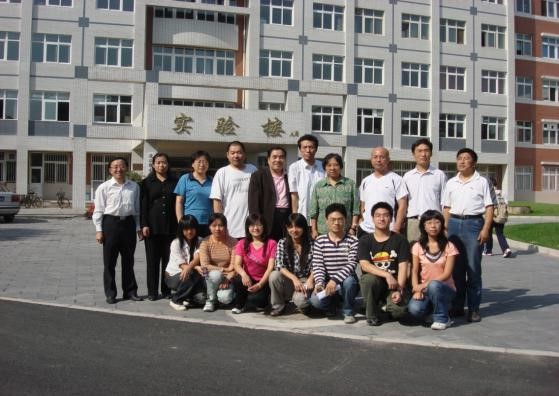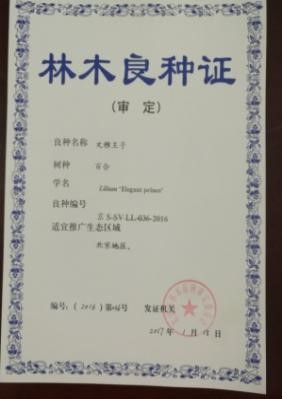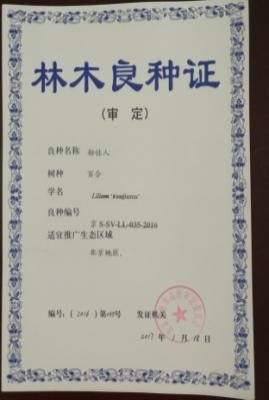- 通知公告
- 活动进展
- 个人风采
- 单位展示
- 百花论坛
北京农学院百合研发团队
北京农学院百合研发团队人员合影
北京农学院百合研发团队,隶属于北京农学院的园林学院。从20世纪80年代末开始的,一直坚持不懈的研究百合已有30年了,现有研究人员9人,其中教授5人,副教授2人,高级技工2人,研究生12人。专门从事百合种质资源与优良品种选育、种质创新、栽培、繁殖、采后贮藏保鲜等方面的研究工作。校内建有百合研发创新基地一处,校外又和云南玉溪明珠花卉企业、内蒙古蒙草生态研究院、北京延庆金河园艺公司合作,联合攻关,大大加强育种步伐。
北京农学院在国内研究百合较早,研究内容比较丰富,以下从百合资源收集及引种试验、百合基础生物特性研究、百合产业化关键技术研究、百合育种研究、百合分子生物学研究、百合花香方面的研究等六方面进行全面总结。
一、百合资源收集及引种试验
北京农学院从上世纪80年代末赵祥云教授就开始百合种质资源的收集和引种试验,先后对我国西北、西南、东北等百合集中分布的地区进行了多次实地考察,曾引种过共计30多种野生百合资源;以不同的目的从国外收集引种各类百合品种约有400-500个,后来根据育种目标的需要,选核心种植资源,集中保存100个左右。 该方面先后出版著作4本,发表的文章等13篇
二、百合基础生物特性研究
开展了解剖学、胚胎学、生理学、细胞生物学等的研究,了解了百合根茎叶营养器官结构、鳞茎贮藏物、花瓣色素种类和含量等,掌握了其胚胎发育过程和对染色体倍性鉴定的方法。该方面发表论文7篇。
三、百合产业化关键技术研究
针对百合生产过程中存在的问题,开展了脱毒组培快繁技术研究、病毒检查研究、鳞片扦插、种球退化等产业化关键技术研究。2005年“一种百合脱毒籽球的快速培养方法”获国家发明专利。该方面发表论文11篇。
四、百合育种研究
该团队较早开展辐射技术进行种质资源创新,近10年来又主要进行了百合杂交育种工作,从资源可利用的角度,研究了花粉活力、杂交组配的亲和性、受精前后不亲和的克服方法、胚抢救、杂种的真实性鉴定方法等,从2000年至2015年培育出庭院百合新品种24个,并全部在英国皇家园艺协会登录。其中‘云景红’‘云丹宝贝’‘文雅王子’‘粉佳人’庭院百合新品种,通过北京市林木良种审定委员会认定。发表论文17篇(详见证书)
五、百合分子生物学研究
近年来结合培养研究生,开展了包括百合再生体系构建、抗病毒和抗病菌、基因克隆、花色形成机理等方面的百合分子生物学研究。发表论文10篇。
六、在百合花香方面的研究
近年来北京农学院冷平生教授团队利用我们收集到的各类百合资源,另辟蹊径,开展了百合花香释放规律及机制的研究,取得了较好的成绩。发表论文8篇。
北京农学院百合研发团队一直坚持产学研相结合,除搞好研究外,还全力投入北京山区百合花卉产业开发应用方面。结合学校教学、科研工作,先后在延庆四海、张山营、大庄科、密云上庄等山区乡镇地建立百合国产化种球示范基地,不分寒暑、不计报酬、没有节假日,常年深入农村基地,总结百合国产化生产中的关键技术,大力宣传普及百合新品种、新技术。带动了延庆、怀柔、密云、平谷、昌平等区县百合生产的发展,编写制定了林业部“全国百合鲜切花栽培技术规程”,并审定“北京市百合切花生产技术规程”和“种球生产技术规程”,为北京地区的百合生产,培训技术骨干300多人次。“百合脱毒籽球的快速培养技术”,“高海拔冷凉山区适合百合种球繁殖生长的成套栽培技术”也推广到我国西南和西北百合种球生产区,对我国百合产业发展做出了应有的贡献。
审定通过的4个良种
Brief Introduction of Research Team of Lily in Beijing University of Agriculture
Research and Development Team of Lily belongs to Landscape Architecture, Beijing University of Agriculture. It currently employs a total of 9 faculties, including 5 professors, 2 associate professors, 2 senior technicians and 12 MSc graduate students. Since the end of 1980s, the research team focused on collection, cultivation, reproduction and innovation of lily germplasm, postharvest storage and fresh-keeping research. It owns Research and Innovation Base in Beijing University of Agriculture, and cooperates with several companies, including Yunnan Yuxi Pearl Flower Co., Ltd., M•Grass and Beijing Jinhe Horticulture Technology Co., Ltd. to tackled key problems in breeding of new lily varieties.
Beijing University of Agriculture carried out lily research from many aspects long ago. We will summarize our achievements in the following six aspects: lily resource collection and introduction experiment, lily basic biological characteristics research, lily industrialization key technology research, lily breeding research, lily molecular biology research, lily fragrance research and so on.
1.
Lily resource collection and introduction experiment
Professor Xiangyun Zhao of Beijing University of Agriculture began collecting and introducing lily germplasm in the late 1980s. She made many field investigations on the distribution of lilies in Northwest, Southwest and Northeast China. More than 30 Lilium species and about 500 Lilium varieties were collected and introduced from home and abroad for different purposes. According to the target of lily breeding, we selected core planting resources and preserved about 100 Lilium species and varieties. Four books and 13 articles have been published in the field.
2.
Lily basic biological characteristics research
Researches on anatomy, embryology, physiology and cell biology were carried out to understand the structure of vegetative organs, including lily root, stem and leave, the substance in bulb during lily storage, the type and content of petal pigments and the embryonic development process. We also founded the method of chromosome ploidy identification. Seven research papers have been published in this field.
3.
Lily industrialization key technology research
Aiming at the problems in lily production process, the key industrialization technologies such as virus-free tissue culture and rapid propagation, virus detection, scales cutting and bulb degeneration were studied. In 2005, ‘A Rapid Culture Method for Virus-free Lily bulb’ was authorized by the State for invention patent. Eleven papers have been published in this field.
4.
Lily breeding research
The team carried out germplasm resources innovation by radiation technology earlier. Lily cross breeding was carried out in recent 10 years. From the perspective of resource utilization, the pollen vigor, compatibility of cross combinations, methods of overcoming incompatibility before and after fertilization, embryo rescue and authenticity identification of hybrid were studied. From 2000 to 2015, 24 new lily varieties for courtyard cultivation were cultivated, and all of them were registered in the Royal Horticultural Society (RHS). Among them, four new varieties for garden cultivation, 'Red Yunjing', 'Yundanbaobei', 'Elegant Prince' and 'Fenjiaren', were identified by Beijing Municipal Forest Variety Examination and Approval Committee. In the field 17 papers have been published. (see Certificate for details)
5.
Lily molecular biology research
In recent years, combined with the cultivation of postgraduate students, molecular biology research on lily has been carried out, including the construction of lily regeneration system, anti-virus and anti-bacteria genes cloning, color formation mechanism and so on. In the research field we have published 10 papers.
6.
Lily fragrance research
In recent years, the Professor Pingsheng Leng from Beijing University of Agriculture has made good use of all kinds of lily resources, which we have collected, to study the regularity and mechanism of lily fragrance release, achieved good results and published 8 papers on lily flower fragrance.
Research and Development Team of Lily in Beijing University of Agriculture has been insisting on the combination of production, teaching and research. Besides researches, it has also devoted all its efforts to the development and application of lily industry in Beijing mountainous areas. Combining with the teaching and scientific research work of the university, we have successively established the demonstration base of lily domesticated seedballs in Sihai, Zhangshanying and DazhuangkeSihai towns of Yanqing distict, Shangzhuang town of Miyun distict and other mountainous villages and towns. We have gone deep into the rural base all the year round, regardless of winter or summer, without pay or holidays, summarized the key technologies in the localized production of lily, and vigorously propagated and popularized the new varieties and new technologies of lily, and promoted the development of lily production in Yanqing, Huairou, Miyun, Pinggu and Changping districts. We have formulated ‘National Lily Fresh Cut Flower Cultivation Technical Rule’ of the Ministry of Forestry, and approved ‘Beijing Lily Cut Flower Production Technical Rule’ and ‘Seed Ball Production Technical Rule’, and trained more than 300 technical backbones for lily production in Beijing. ‘Rapid cultivation technology of lily virus-free seed balls’ and ‘Cultivation techniques suitable for lily bulb propagation and growth in cold mountain areas at high altitude’ have also been popularized to lily bulb production areas in southwest and northwest China. Research and Development Team of Lily in Beijing University of Agriculture has made due contributions to the development of lily industry in China.






